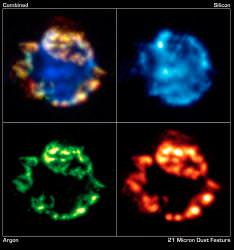My kids find it fascinating that the gold in the ring on my finger was formed in an instant when a massive star detonated in a supernova explosion. But it’s not just the heavier elements that get produced in a supernova, there’s also dust. Lots and lots of dust that can eventually collect together into new planets. And according to NASA’s Spitzer Space Telescope, a typical supernova remnant called Cassiopeia A contains enough dust for 10,000 Earths.
This discovery helps solve one of the outstanding mysteries in astronomy: where did all the dust from the early Universe come from? After the Big Bang, the Universe was only made of hydrogen and helium, and a few trace heavier elements. The first stars formed from this primordial material, and then exploded as supernovae, producing the first heavier elements and the dust needed to make terrestrial planets.
Astronomers always thought that supernovae were prime contributors, recycling material in generation after generation, but they weren’t sure – until now.
Another source of this dust seems to be highly energetic black holes, called quasars, which might be firing out high speed jets and dust to seed solar systems.
The Spitzer observations of Cassiopeia A, located about 11,000 light-years away, showed that the warm and cold dust ejected during the supernovae explosion adds up to about 3% the mass of the Sun.
Their observations show that the dust contains proto-silicates, silicon dioxide, iron oxide, pyroxene, carbon, aluminium oxide and other compounds. You could fashion 10,000 planets with the mass of the Earth with that much material.
Although Cassiopeia A is nearby, and not one of those first stars, it wasn’t working with the same raw primordial materials. But the research shows that exploding massive stars do a fine job of turning raw hydrogen and helium into the dust needed to form planets like Earth.
Original Source: Spitzer News Release


Wouldn’t the gold formed also be in the form of dust?
Of course, so would the uranium, iron and all other elements made by the explosion. However, the author is primarily talking about the various oxides and silicates mentioned.
“Wouldn’t the gold formed also be in the form of dust?”
But not as gold dust, but as scattered atoms of gold mixed in with everything else. The separation process probably requires a planet, maybe a rocky planet, and probably water, and geologic time, and on and on.
First, the dust clumps together through gravitational attraction, slowly growing until it acquires enough mass to generate heat at the core through gravational compression, friction, impacts, etc. As the material heats up and melts, the different elements and compounds separate as each has a different melting point, with the heavier metals sinking to the core, the iron, uranium, etc.